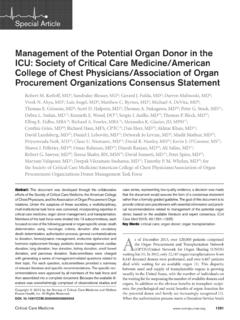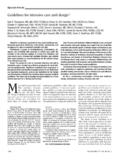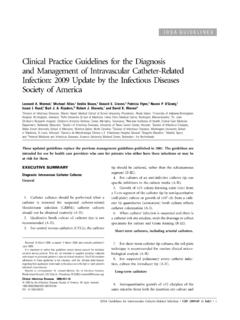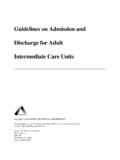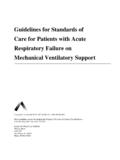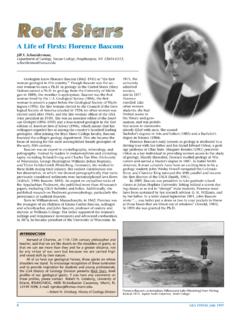Transcription of Recommendations for end-of-life care in the …
1 Special ArticlesRecommendations for end-of-life care in the intensive careunit: A consensus statement by the American college ofCritical Care MedicineRobert D. Truog, MD, MA; Margaret L. Campbell, PhD, RN, FAAN; J. Randall Curtis, MD, MPH;Curtis E. Haas, PharmD, FCCP; John M. Luce, MD; Gordon D. Rubenfeld, MD, MSc;Cynda Hylton Rushton, PhD, RN, FAAN; David C. Kaufman, MDThe primary goals of intensivecare medicine are to help pa-tients survive acute threats totheir lives while preservingand restoring the quality of those goals are frequently achieved, withapproximately 75% to 90% of patientsadmitted to an intensive care unit (ICU)surviving to discharge (1).
2 Even so, theICU has become a common place to die;studies show that 22% of all deaths in theUnited States now occur in or after ad-mission to an ICU (2).Admission to the ICU is therefore of-ten a therapeutic trial. Only when thetrial fails do patients and families con-sider a change in goals, from restorativecare to palliative care. This change, whichhas been called the transition from cureto comfort, is one of the most difficultand important aspects of medical andnursing practice in the ICU (3). Twotruths ensure that this transition will re-main difficult, despite our best efforts. First is the widespread and deeply helddesire not to be dead.
3 Second is medi-cine s inability to predict the future, andto give patients a precise, reliable prognosisabout when death will come. If death is thealternative, many patients who have only asmall amount of hope will pay a high priceto continue the struggle (4).The purpose of these recommenda-tions is to improve the care of patientsduring this transition and through thedying process. These recommendationsBackground:These Recommendations have been developed toimprove the care of intensive care unit (ICU) patients during thedying process. The Recommendations build on those published in2003 and highlight recent developments in the field from a They do not use an evidence grading system becausemost of the Recommendations are based on ethical and legalprinciples that are not derived from empirically based Findings:Family-centered care, which emphasizesthe importance of the social structure within which patients areembedded, has emerged as a comprehensive ideal for managingend-of- life care in the ICU.
4 ICU clinicians should be competent inall aspects of this care, including the practical and ethical aspectsof withdrawing different modalities of life -sustaining treatmentand the use of sedatives, analgesics, and nonpharmacologicapproaches to easing the suffering of the dying process. Severalkey ethical concepts play a foundational role in guiding end-of-life care, including the distinctions between withholding andwithdrawing treatments, between actions of killing and allowingto die, and between consequences that are intended vs. those thatare merely foreseen (the doctrine of double effect). Improvedcommunication with the family has been shown to improve pa-tient care and family outcomes.
5 Other knowledge unique to end-of-life care includes principles for notifying families of a patient sdeath and compassionate approaches to discussing options fororgan donation. end-of-life care continues even after the death ofthe patient, and ICUs should consider developing comprehensivebereavement programs to support both families and the needs ofthe clinical staff. Finally, a comprehensive agenda for improvingend-of- life care in the ICU has been developed to guide research,quality improvement efforts, and educational : end-of-life care is emerging as a comprehensivearea of expertise in the ICU and demands the same high level ofknowledge and competence as all other areas of ICU practice.
6 (Crit Care Med 2008; 36:953 963)KEYWORDS: ethics; intensive care unit; end-of-life ; palliativecare; decision making; quality improvementFrom Harvard Medical School and Children s Hos-pital, Boston, MA (RDT); Detroit Medical Center andCenter for Palliative Care Excellence, Wayne StateUniversity, Detroit, MI (MLC); University of Washington,Seattle, WA (JRC); Department of Pharmacy, StrongHealth, and Department of Surgery, School of Medicineand Dentistry, University of Rochester, Rochester, NY(CEH); University of California, San Francisco, CA(JML); Division of Pulmonary and Critical Care Medi-cine, Harborview Medical Center, University of Wash-ington, Seattle, WA (GDR); Harriet Lane CompassionateCare and Berman Bioethics Institute, Johns HopkinsUniversity and Children s Center, Baltimore, MD (CHR);and University of Rochester, Rochester, NY (DCK).
7 The American college of Critical Care Medicine(ACCM), which honors individuals for their achieve-ments and contributions to multidisciplinary criticalcare medicine, is the consultative body of the Societyof Critical Care Medicine (SCCM), which possessesrecognized expertise in the practice of critical ACCM has developed administrative guidelinesand clinical practice parameters for the critical carepractitioner. New guidelines and practice parametersare continually developed, and current ones are sys-tematically reviewed and Rubenfeld has held a consultancy with remaining authors have not disclosed any poten-tial conflicts of information regarding this article, 2008 by the Society of Critical CareMedicine and Lippincott Williams & WilkinsDOI: Care Med 2008 Vol.
8 36, No. 3build on those published in 2001 (5) andhighlight recent developments in thefield from a perspective. The recom-mendations do not quantitatively gradethe level of evidence because most of therecommendations are based on ethicaland legal principles that are not derivedfrom empirically based and Family-CenteredCare and Decision MakingFamily-centered care, which sees pa-tients as embedded within a social struc-ture and web of relationships, is emergingas a comprehensive ideal for end-of-life carein the ICU (6, 7). This approach hasimpor-tant implications for decision making for Decision theUnited States and many other countries,limiting life support is ethically and le-gally justified under the principle of au-tonomy.
9 Law grants patients with de-cision-making capacity the right to refuseany and all therapies, including those thatsustain life (1). This standard is problematicin the ICU, however, where as many as 95%of patients may not be able to make deci-sions for themselves because of either theirillness or sedation (8).When patients cannot make decisionsfor themselves, decisions are made on theirbehalf by surrogates, using either the sub-stituted judgment standard (if the pa-tient s values and preferences are known)or the best interests standard (if they arenot). While these decisions areoftenreached by consensus with the patientand family, patients do have an opportu-nity to designate a specific individual as ahealthcare proxy.
10 When no individual hasbeen specifically designated, many statesdefine a legal hierarchy for choosing adesignated surrogate (1). Table 1 providessome of the legal precedents for theseprinciples in American guidelines regarding end-of-lifedecision making are less clear when pa-tients without capacity lack an appropri-ate surrogate. Some states allow physi-cians to make decisions for such patientsbased on wishes expressed to the physi-cians when the patients had , no state explicitly allows physi-cians to make decisions based on theirview of the best interests of the patient(1). In general, we recommend againstadhocdecision making in these circum-stances.
